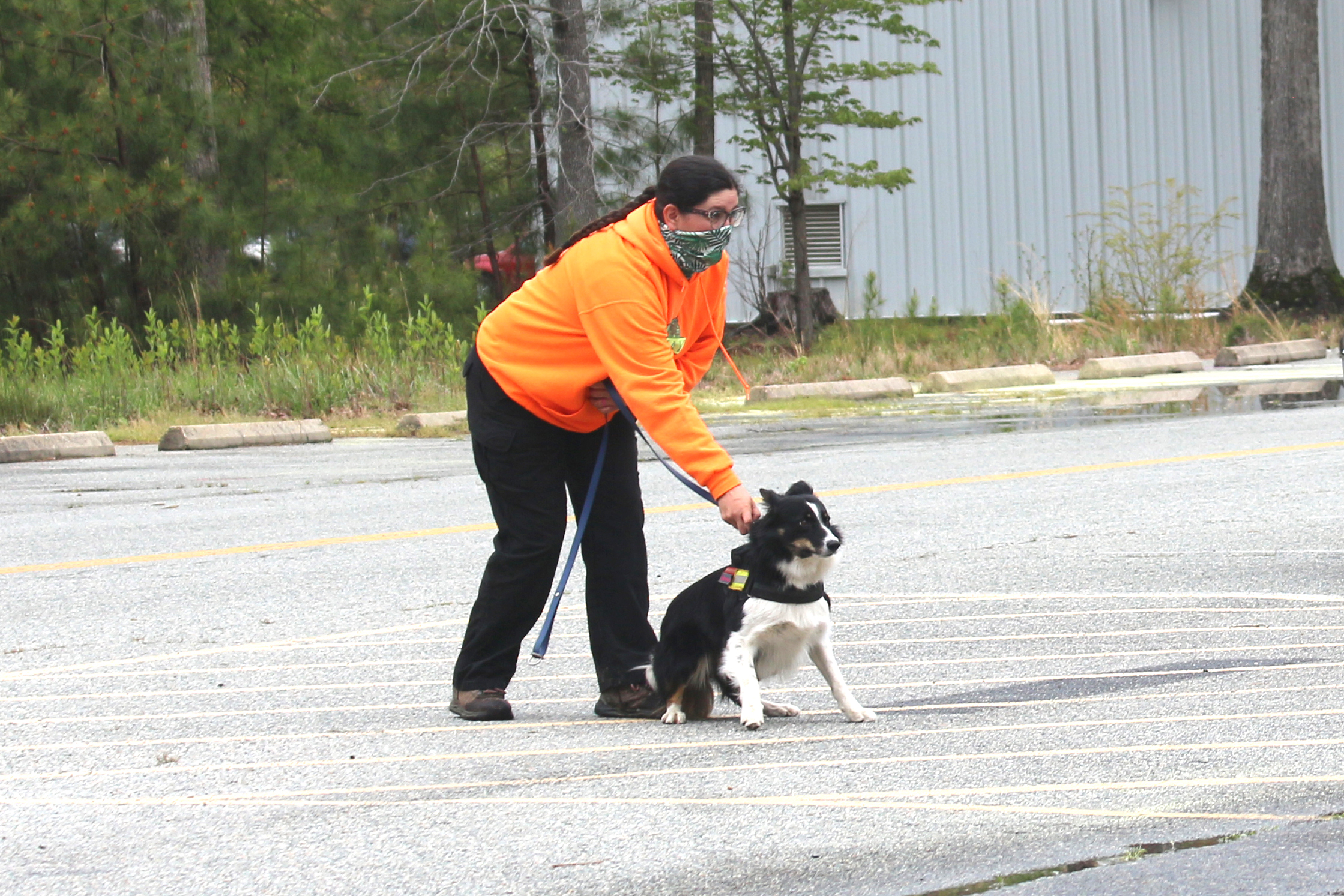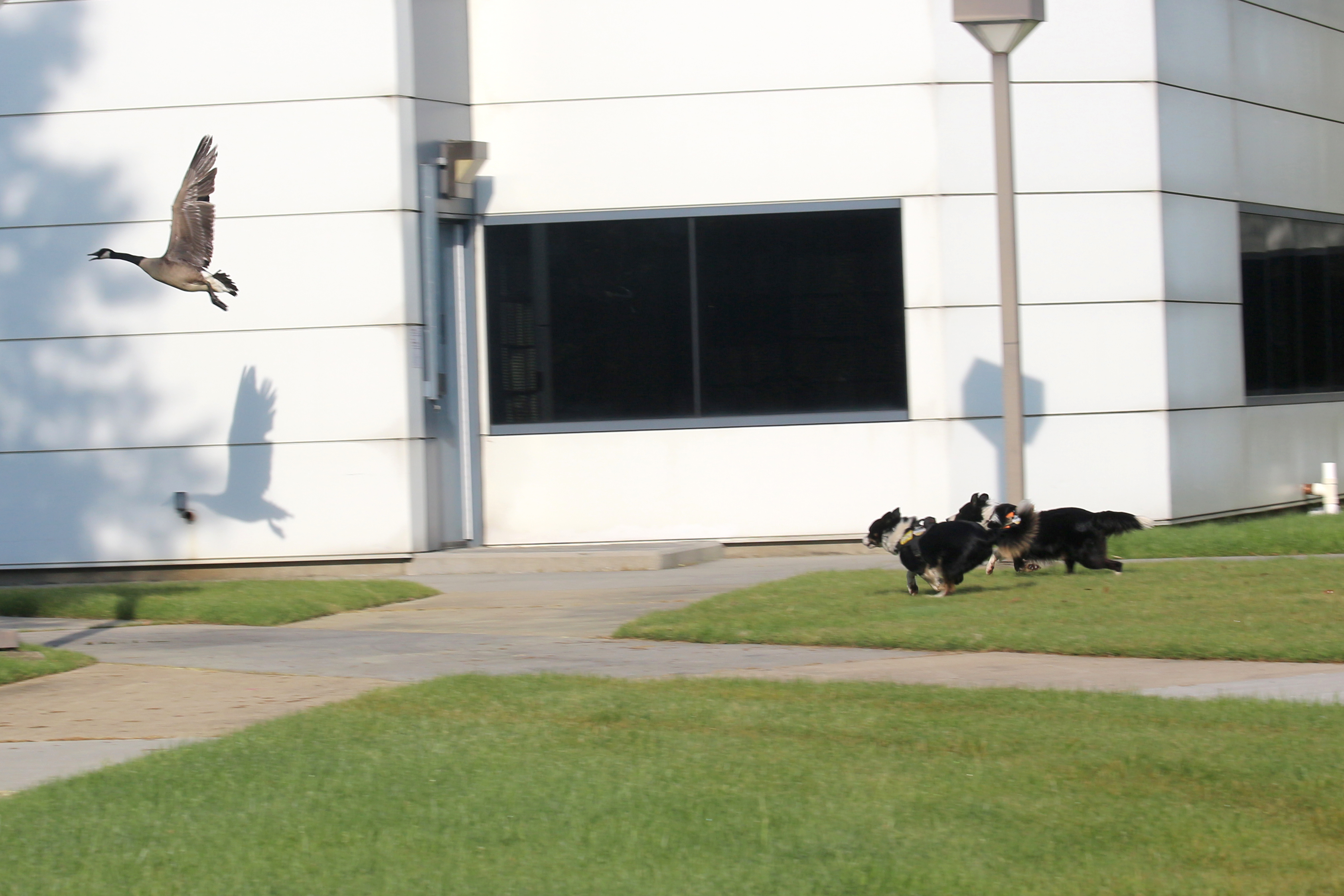Man’s best friend aims to keep feathered flocks in check
NEWPORT NEWS, VA – The campus at the U.S. Department of Energy’s Thomas Jefferson National Accelerator Facility has many perks, including open stretches of grass, park-like landscaping and water features. The facilities make a healthy, productive and attractive work environment. Unfortunately, these perks also make the campus a little too attractive to some non-working guests.
“For as long as I can remember, we have had a goose population that enjoys calling Jefferson Lab home year-round. But during the recent reduction in operations due to COVID, the lack of people and traffic have made our grounds too attractive,” shared Rusty Sprouse, manager of Jefferson Lab’s Facilities Management & Logistics division.
While there are some positive benefits to having resident, non-migratory geese present on the site, there are a few concerns with the very active and growing goose population on the Jefferson Lab campus. An overabundance of geese on-site can have negative impacts on the site’s ecology, environment and workers.
Overpopulation of an area by resident geese can have a negative impact on locally native aquatic plants and insects, fish and other wildlife. Geese can also become quite aggressive to people in their space. If the population is not controlled and monitored, areas of shared space can become unusable for humans, due to the threatening behavior of the geese.
In addition, there is an obvious need to continually clean up the waste these feathered friends leave behind in well-trafficked areas. While it’s unclear whether germs in waste on the ground can directly impact human health, wildlife experts have urged that the public avoid direct exposure to it and take caution with items that have been exposed. There’s also concern that contaminated areas become slip and fall hazards that could have been avoided with proper management.
“We have deployed a number of methods over the years to control their access and impact, but our tactics have stopped being effective,” said Sprouse.
Spring-actuated shadow dogs, for instance, have been used throughout the campus for many years, but they are becoming less effective as the geese learn to not fear them. This conditioned learning is called habituation and can happen with several goose deterrent methods.
After evaluating other techniques to supplement their geese control methods, Facilities Management & Logistics personnel decided it was time to try a new solution to reverse the goose population explosion in time for the anticipated return of more staff, students and visitors this summer. The new management plan lets the dogs out to help.
“In a former position, I successfully worked with trained dogs to help alleviate the biological impacts to a facility campus and also humanely deter the geese from facilities,” said Sprouse. “They relieve the coordination strain from moving shadow dogs and are more effective than noise-based solutions, especially given our need for help during working hours.”
Jefferson Lab is partnering with North Carolina-based Flyaway Geese, a business that features teams of border collies and their handlers who have worked across the country controlling migrant bird populations. Locally, their work includes helping to control predatory bird species that threaten the protected seabird nesting colony on the South Island of the Hampton Roads Bridge-Tunnel for the Virginia Department of Transportation, in partnership with the Virginia Department of Wildlife Resources.
The goosedog teams have already begun visiting the lab campus. For the first month, the teams plan to visit the site up to two to three times a day, every day of the week. After that, on-site visits will become less frequent, depending on the geese population’s reaction and conditioning of former habits. To help prevent habituation, the teams will be visiting at a variety of times throughout the day.
The team will concentrate on deterring the geese from around the accelerator site, populated areas and buildings; however, you will likely still see them out and about in the green spaces around the lab’s campus.
“Geese are very intelligent and are able to learn what they should and should not be afraid of,” said Rebecca Gibson, owner of Flyaway Geese. “It’s our job to protect the goose population by helping them navigate to a safer space that does not have the potential for conflict with humans.”
The Flyaway Geese team is made up of several handlers that partner with skilled and nimble border collies. Gibson shared that the goosedogs may look a little wild as they bolt across fields, but that they are highly trained and controlled.
“Each dog wears a vest that identifies them as a goosedog and clearly shows that they are on the clock,” she shared.
The dogs on her teams have been in the business for several years each and go through an intense training period of one to two years. She said that border collies are singularly qualified for bird population control, because they are herding dogs by nature and have no kill instinct.
“Border collies stalk and herd birds and adopt a similar body posture to that of a wolf, coyote or fox. Since those animals are natural predators to birds that spend time on the ground, it triggers a predator response in the brain of the bird,” said Gibson.
Lab staff should anticipate seeing the border collies on-site frequently. The goosedog teams have the goal of persuading the geese to prefer the open green spaces surrounding the lab, such as a nearby lake or pond that has capacity. Here’s a video that shows how using goosedogs to redirect the birds to an alternative site can be humane and effective.
The Flyaway Geese teams will be seen throughout the lab campus, and they are happy to say hello if they are not actively directing geese.
“Our dogs are all friendly, so staff should feel comfortable saying hello to the teams anytime the dogs are leashed. We just ask that active dogs aren’t interrupted…they really enjoy their work,” Gibson added.
Border collies are hard workers and enjoy the time they spend herding and chasing geese.
“My dogs see lots of birds as we travel, and I’m convinced that they would chase them forever if we let them. Herding birds is no different than a border collie herding cows or sheep, it’s literally in their instinct to protect and care for their charges,” shared Gibson.
During their training and time off, the border collies enjoy any toys that make noise and involve the chase. Frisbees and tennis balls, especially with squeakers, are popular among the canine workers.
By Jessica Bedenbaugh
Contact: Kandice Carter, Jefferson Lab Communications Office, kcarter@jlab.org




